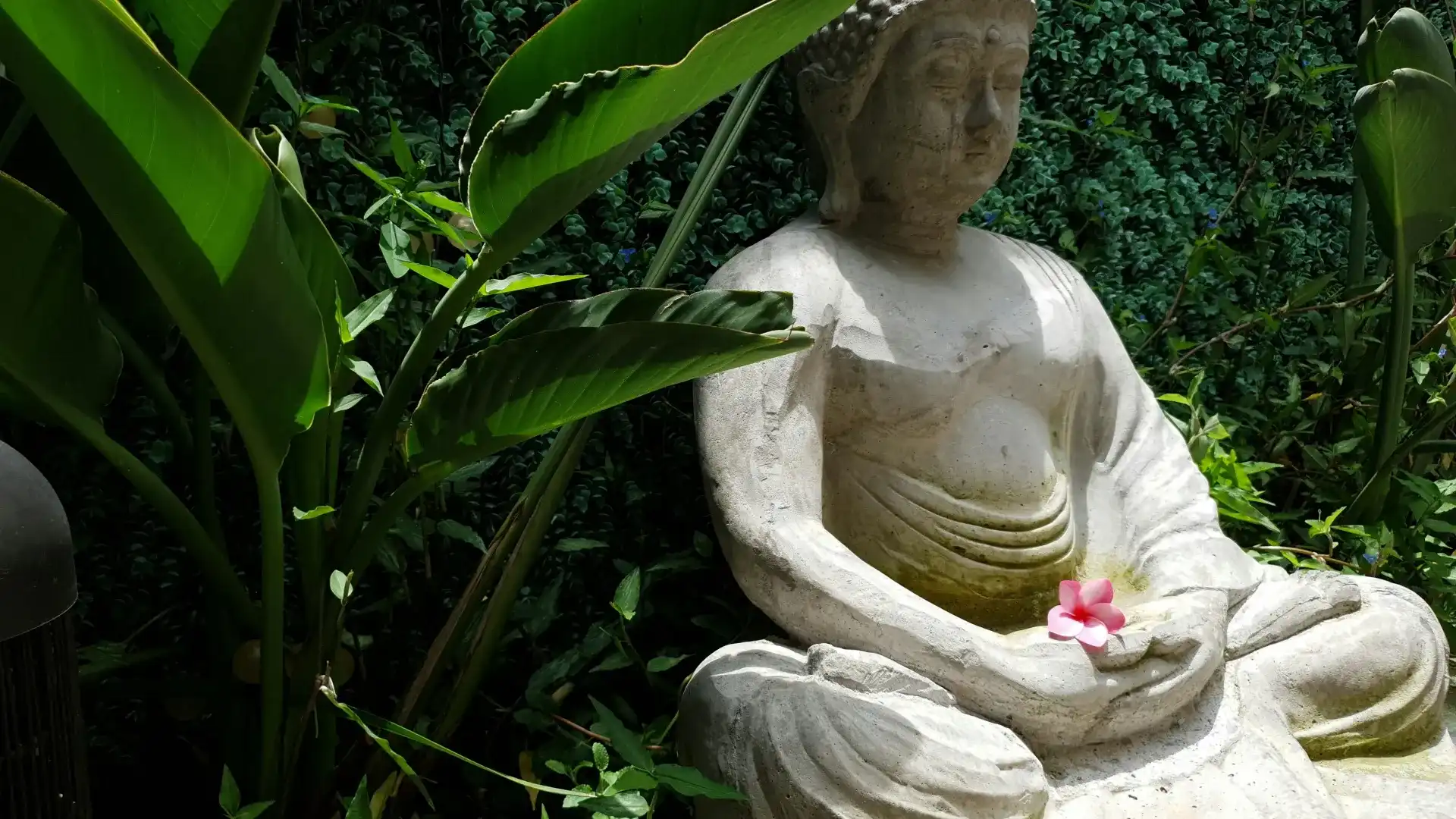Circle walking and seated meditation are two Taoist practices that help improve focus, reduce stress, and balance energy (Qi). Here’s how they compare:
- Circle Walking: Involves walking in a circular path with mindful breathing. It’s active, great for releasing tension, and aligns energy with natural rhythms.
- Seated Meditation: Focuses on stillness, breath observation, and inner calm. It’s ideal for deep reflection and gathering energy.
Quick Comparison:
| Aspect | Circle Walking | Seated Meditation |
|---|---|---|
| Movement | Active, continuous | Still, stable |
| Energy Flow | Dynamic, flowing | Centered, grounding |
| Focus | Movement-based | Breath/thoughts |
| Best For | Restlessness, beginners | Deep introspection |
Tip: Combine both for a balanced practice. Start with circle walking to release tension, then transition to seated meditation for deeper focus. Try 10–15 minutes of each daily for the best results.
Circle Walking Meditation Basics
History and Taoist Roots
Circle walking meditation, also known as Zhuan Zhuan, originates from ancient Taoist traditions. This practice aligns movement with natural rhythms, encouraging the flow of qi (life energy). It emphasizes mindfulness and balance, forming the groundwork for its practical application.
Main Methods
The practice involves walking along a circular path, either visualized or physically marked. While walking, practitioners focus on their breathing and maintain a relaxed, upright posture. Movements are steady and smooth, aiming to harmonize the body and breath.
Physical and Mental Effects
Practicing regularly can enhance balance, coordination, and body awareness. It also sharpens focus and helps reduce stress. The continuous motion supports the flow of qi, promoting emotional stability and a sense of harmony.
Seated Meditation Fundamentals
Basic Techniques
Start by finding a position that feels comfortable - either sitting cross-legged on a cushion or on a chair with your feet flat on the ground. Keep your posture upright but relaxed.
Focus on your natural breathing without trying to change it. Over time, you can add diaphragmatic breathing, allowing your belly to expand as you inhale and contract as you exhale. Keep your eyes gently closed or softly focused on a spot about three feet in front of you. This simple setup helps create a sense of calm and prepares you for deeper practice.
Core Principles
Seated meditation is built on three key ideas:
- Present-moment awareness: Paying attention to your current experience without judging it.
- Non-attachment: Observing thoughts and sensations without clinging to them.
- Inner stillness: Quieting the mind while staying alert and focused.
Start with 10–15 minutes a day and gradually increase the time as your focus improves. It's better to meditate consistently in shorter sessions than to aim for longer, irregular ones.
Main Outcomes
Practicing seated meditation regularly can lead to physical benefits like lower blood pressure, better sleep, and improved breathing. Mentally, it can help sharpen focus, regulate emotions, and ease stress.
Unlike movement-based practices like circle walking, seated meditation builds internal energy (or qi) through stillness. Meditating early in the morning, when distractions are fewer and the mind is naturally clear, can make your practice even more effective.
Differences Between Methods
Movement vs. Stillness
Seated meditation emphasizes complete stillness to develop a deep inner focus. On the other hand, circle walking uses continuous, rhythmic movement to anchor awareness. This movement-based approach can be especially helpful for individuals who find long periods of stillness challenging, while also incorporating a sense of spatial awareness into the practice.
Effects on Mind and Emotions
Circle walking, with its rhythmic physicality, impacts emotional states differently than seated meditation. Sitting still allows for deep introspection, giving space to observe and reflect on thoughts without external distractions. Circle walking, however, helps release emotional tension while keeping the mind engaged, making it a more approachable option for those new to meditation.
Energy and Qi Dynamics
These two practices also influence Qi, or vital energy, in unique ways. Circle walking, with its circular patterns, aligns with natural energy flows, promoting harmony with universal rhythms. Seated meditation, by contrast, encourages energy to settle and gather through stillness, reflecting the Taoist principle of balancing action with rest.
Here's a comparison of energy dynamics between the two methods:
| Aspect | Circle Walking | Seated Meditation |
|---|---|---|
| Energy Movement | Dynamic, flowing | Still, accumulating |
| Physical Engagement | Active, continuous | Minimal, stable |
| Focus Type | Movement-based awareness | Breath/thought observation |
| Primary Energy Pattern | Circular, expansive | Centered, grounding |
Both practices aim to deepen mindfulness and spiritual awareness, offering distinct approaches that cater to individual preferences and goals.
sbb-itb-4c1eb9b
CIRCLE WALKING FUNDAMENTALS
Combining Both Methods
Blending circle walking with seated meditation brings together the strengths of both practices, creating a more balanced flow of energy and a deeper sense of mindfulness.
Why Combine These Practices?
Circle walking prepares both your body and mind for seated meditation. When practiced together, they:
- Encourage both active and passive mindfulness
- Help maintain steady energy levels throughout the day
- Build physical stamina while nurturing mental calm
- Offer varied techniques to support meditation progress
This approach is especially helpful if sitting still for long periods feels challenging. Starting with circle walking helps release physical tension and mental restlessness, making it easier to settle into seated meditation.
Suggested Daily Routine
A consistent routine can help you get the most out of these practices.
Morning Session (20-30 minutes)
- Spend 10-15 minutes circle walking to wake up your body and align your energy.
- Follow with 10-15 minutes of seated meditation while your mind is fresh.
- Keep your attention on your breath throughout the session.
Evening Session (20-30 minutes)
- Start with 15 minutes of circle walking to unwind from the day.
- Transition into 15 minutes of seated meditation to relax and let go.
- Focus on releasing tension and finding calm.
Tips for Weekly Practice
- Alternate between the two practices based on how you feel.
- Use circle walking when you’re feeling restless or distracted.
- Opt for seated meditation when you want to reflect more deeply.
- Adjust the balance of your practice as needed, listening to your body.
If you’re just starting, begin with shorter sessions and gradually increase the time. Consistency is more important than length. Over time, you’ll discover the balance that works best for you.
For guidance on proper form and breathing, refer to earlier sections. Combining these methods provides a flexible meditation practice that can grow and adapt to your needs.
Conclusion
Main Points Review
Circle walking encourages active body awareness, while seated meditation cultivates focused stillness. Both practices align with Taoist principles and, over time, can help reduce anxiety, improve mental clarity, and deepen self-awareness. By combining movement and stillness, you can create a balanced approach that benefits both your mind and body.
Getting Started
Here’s how to begin your meditation journey:
For Circle Walking:
- Choose a quiet, open area.
- Start with short, 5-minute sessions.
- Focus on mindful steps and natural breathing.
For Seated Meditation:
- Use a comfortable cushion or chair.
- Begin with 3- to 5-minute sessions.
- Sit with your spine naturally aligned and focus on your breath.
Both approaches reflect the simplicity of Taoist practice. As you establish your routine, you’ll naturally discover whether one method - or a blend of both - suits your mindfulness journey best. Stay patient and consistent for the best results.






